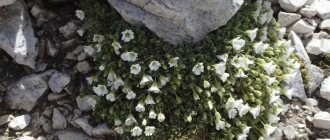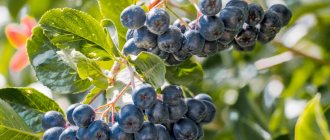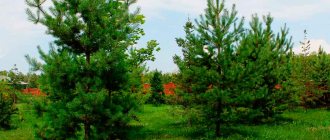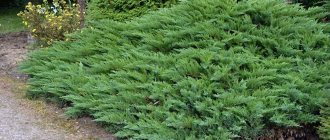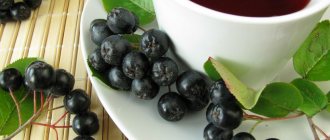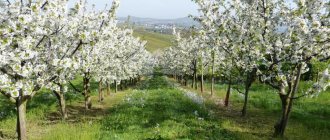Planting and caring for chokeberry does not require special skills or craftsmanship. Vigorous, resilient chokeberry develops well, receiving minimal care typical of fruit trees and bushes in the garden. Proper planting largely determines the further development of black rowan. The culture has few peculiarities and vagaries. But only by taking them into account, you can grow truly beautiful, healthy and productive black chokeberry.
How to plant chokeberry
Errors made when choosing a time or place, insufficient soil preparation, or improper placement of chokeberry seedlings in the soil may not have an immediate impact. Correcting such defects can be difficult.
For successful cultivation of chokeberry, the main requirement for the planting site is sufficient lighting. Chokeberry lays fruit buds along the entire periphery of the bush; for full flowering and uniform growth, a lot of sunlight is needed. Even partial shading has a bad effect on the decorative effect of black rowan.
Self-pollinating black chokeberry is able to bloom and bear fruit in single plantings. And yet, proximity to related crops (for example, red rowan) has a beneficial effect on productivity. The ability of chokeberry to tolerate pruning well and grow in dense groups is used when creating free-form hedges.
Where to plant chokeberry
The unpretentious chokeberry can take root in a variety of soils. It grows on sandy, rocky slopes, and in wetlands. But still, the best results are obtained by growing chokeberries on well-drained loams with low acidity. Loose fertile soil and a sunny place are the best choice for chokeberry.
The bulk of the root system of black rowan lies no deeper than 50 cm. It is not afraid of spring flooding. Groundwater that comes close to the surface does not cause any harm to black chokeberry.
Advice! Seedlings should be protected from cold winds. Mature chokeberry plants themselves will serve as a shield for the garden. You can plant chokeberry along the edge of the plot on the leeward side. When creating protection in the fields, chokeberry is used to fill the middle tier of the forest belt.
When to plant chokeberry
Early spring is suitable for planting chokeberry. When choosing dates, pay attention to the climatic conditions in a particular area: the duration of the warm period, the severity of the climate, the presence of recurrent frosts.
Healthy chokeberry planting material for spring work should have swollen, living buds, but still without leaves. Chokeberry should be planted in the spring after the soil has completely thawed. It is advisable to complete the work before the active growing season begins. Most often this period is observed in April. Planting in the spring gives young black chokeberries a full season to actively grow before going into winter.
Sudden cold snaps in spring are dangerous for young shoots. When there is a threat of return frosts in the spring, black chokeberry seedlings are covered.
How to plant chokeberry correctly
The planting site, as well as the nutrient substrate for the roots, is prepared in advance. The minimum pit size for a chokeberry seedling is 50 cm in width and depth. Even if the rowan roots are small, the place is prepared as standard. The entire volume of the planting pit will be used by the chokeberry during the growth of the bush.
The soil removed when digging a hole is mixed with humus (10 kg), wood ash (about 2 tbsp.) and 1 tbsp. superphosphate. Seats are located at a distance of 3 m from each other. When forming a hedge from black rowan, a slight thickening is permissible, but not closer than 2 m.
The process of planting chokeberry step by step:
- The planting hole is filled 1/3 with the prepared nutrient substrate.
- Spray with well-settled water and wait until it is completely absorbed into the soil.
- The chokeberry seedling is placed in the center of the hole so that after planting the root collar is above the soil.
- The hole is completely filled with fertile substrate, and the soil is pressed around the seedling.
- The chokeberry planting site is watered abundantly. After the soil has settled, it is mulched with a layer of about 2 cm.
Comment! Before planting black rowan, the shoots on the seedling are shortened to 5 living buds. This will make rooting easier, and the plant will more readily begin to grow.
What can be planted next to chokeberry
An important factor when choosing a neighborhood for chokeberry is the height of the plants. The chokeberry's requirement for light requires care that surrounding trees and bushes do not shade it even partially.
So, when planting chokeberry and red rowan next to each other, the first one is placed further south. She finds it harder to bear the shadow of her tall relative. Any types of wild and cultivated varieties of rowan get along well side by side and benefit from cross-pollination.
Black chokeberry easily tolerates any neighborhood in the garden. It is not planted only near cherries, due to the presence of pests (aphids and sawflies) that attack both plants. Other garden trees and shrubs tolerate planting well next to chokeberry.
Garden crops also have no contraindications for growing in the same area as chokeberry. However, sometimes there is mutual infestation of aphids in chokeberries with berry crops: strawberries, raspberries, currants.
Is it possible to plant chokeberry near an apple tree?
The apple tree is one of the most tolerant trees in the garden. Like chokeberry, it is undemanding to its neighbors. Joint planting can be beneficial for both crops, provided they do not shade each other.
By leaving some of the black berries on the chokeberry, birds are attracted to the garden. Such natural destruction of pests benefits the apple tree. Preventive treatments of crops against diseases can be carried out together, at the same time, with the same preparations. Therefore, the proximity of black rowan and apple trees can be called successful.
Brief history, description and characteristics of the plant
Chokeberry is also called Chokeberry. It grows wild in the eastern regions of North America. This is a shrub reaching 3 meters in height, with a crown diameter of more than 2 m. It is very winter-hardy. The root system does not spread far, but some roots penetrate up to 1 meter or more, although the bulk of them reach a depth of about half a meter. An adult bush has numerous thick branches-trunks. The leaves are simple, broadly oval or elongated. The edge of the leaf is jagged. The leaf blade is shiny, dense on top, slightly pubescent and whitish on the underside.
Blooms in May-June. Flowering lasts about 10 days. The flowers are medium-sized, white, bisexual. The corolla has five petals. Chokeberry peduncles are in the form of a shield containing from 15 to 35 flowers, and the berries grow accordingly: in the form of small bunches of shields. It takes about three months for the fruit to grow and ripen.
When planting a chokeberry bush at the dacha, you need to understand in advance that it will take up a lot of space
The fruit is round, black, with a slight bluish coating, strongly wrinkled at the end, quite large (0.5 to 1.5 cm in diameter), tastes sweet and sour, astringent, tart. The weight of one berry is 1.0–1.5 g. Each berry contains 4–8 small seeds. The fruits contain up to 10% sugar, 1.3% acids (mostly malic), pectin and other beneficial substances. The flowers and fruits of chokeberry resemble the flowers and fruits of the common rowan.
This rowan begins to bear fruit in the fourth year of life. The berries ripen at the end of September and do not fall for a long time. Chokeberry is a completely winter-hardy crop. It grows especially well in moisture-intensive, fertile soils. In dry years, the berries are less juicy and small, so they are planted in well-lit places.
I.V. Michurin drew attention to this valuable shrub and recommended it for cultivation for economic purposes. In 1900, he purchased chokeberry cuttings from Germany to cross with red rowan.
The initiator of the widespread introduction of chokeberry into agricultural production is M. A. Lisavenko (Altai). In 1935, he took cuttings in Michurinsk, propagated them, and then planted a plantation of a thousand bushes. Its widespread distribution was also facilitated by numerous amateur gardeners who began planting soon after the war. Then the seedlings were brought to the north, to the Leningrad region, from where rowan came to the Baltic states and other regions. In Russia today, chokeberry is widespread as a fruit and medicinal crop. It is grown everywhere, especially in the middle zone and northern regions.
Varieties of chokeberry
Half a century ago, one could read that there are only a few varieties of chokeberry. Now this is not true: through the efforts of breeders, varieties have been developed that differ not only in early ripening or different growing conditions, but also in taste and even color of berries, although in appearance most of them are very similar to each other and are practically indistinguishable. However, the list of the most popular chokeberry varieties among lovers is still small.
The appearance of chokeberry berries of different varieties differs little; only specialists know them by sight
The unpretentious variety Rubina is characterized by increased resistance to diseases, pests and frost. The berries ripen in September, have a round shape, up to 1 cm in diameter, and low astringency.
Rowan Black-eyed is also very unpretentious, similar in characteristics to Rubina, but loves sunnier areas. Diseases most often bypass Black-Eye. Its berries, unlike most varieties, have almost no astringency. They hang on the branches for a long time without falling off, so they can be collected in one go.
It is recommended to plant the Czech variety Nero in shaded areas. It can withstand the most severe frosts, the bush is not too large, the maximum height is up to 2 meters. The color of the flowers is interesting: the main color, like most varieties, is white, but the stamens are red. The berries have an improved taste, aroma and increased vitamin content, are well suited for making juice, and ripen somewhat earlier than other varieties.
One of the most winter-hardy and late varieties is Aronia Michurina, which can withstand cold temperatures down to -40 °C. It grows as a very large bush, over 3 meters. The berries are also larger than usual, not quite round, slightly flattened, very juicy, and do not fall off. They are quite suitable for direct consumption, having a sweet and sour taste.
Chokeberry Michurina is one of the most honored, traditional varieties
The Viking variety (of Finnish origin) is also highly winter-hardy, but is distinguished by its compact bush size and rather small berries, 10–20 per cluster. At the same time, the total harvest of fruits, which are not entirely black in color, with a hint of purple, is still quite considerable. The berries are slightly flattened in shape and can hang on the bushes until the end of October.
Bushes of medium height with a round crown of the Swedish variety Hugin. The berries are red-black, below average size, ripen a little later than other varieties, and are not very juicy. Hugin is relatively capricious in care: he does not like radical pruning of bushes. In autumn, chokeberry bushes of this variety are very decorative: dark green shiny leaves are adjacent to bright red ones, with a gradual shift in the general background color towards crimson tones. The winter hardiness of the variety is high, but the soil around young plantings should be well mulched for the winter.
Healing properties of the plant
The healthfulness of chokeberry lies mainly in the fact that its berries contain a lot of vitamin P. The composition includes active coloring and colorless substances (catechins, red anthocyanins, yellow flovones). The fruits also contain other vitamins - C, PP, B2, B9, E, but in relatively small quantities. Aronia fruits are a rich source of natural food coloring and contain many tannins. Chokeberry berries are useful in the treatment of certain diseases, including radiation, since vitamin P is an anti-radiant. Berries and juice are best consumed together with the fruits of other plants rich in vitamin C.
Chokeberry juice contains chemical elements useful for the human body: iodine, iron, manganese. It makes quite good wine and is also used to tint light wines, sparkling water and other drinks. The juice yield from the fruit is high - 68–75%.
Chokeberry tincture is easier to prepare than classic wine, and is valued no less by lovers
For preventive and medicinal purposes, juice, fresh, frozen or dried berries, and various culinary products from rowan are consumed. It is useful for hypertension, bleeding, diabetes, kidney disease, rheumatism, hepatitis and many other cases. Chokeberry helps reduce cholesterol in the blood. When eaten fresh, this rowan is not very tasty, so they prefer to make jam, marmalade, compote, etc. from it. If the cooking rules are followed, it does not lose its healing properties.
How to transplant chokeberry to a new place
With timely planting and good care, black rowan quickly turns into a large bush, and after 2–3 years it begins to bear fruit. But sometimes there is a need to move an adult plant to another place. It is better to carry out such work in early spring, before the leaves bloom on the chokeberry.
The vitality of chokeberry allows it to take root successfully even in adulthood. If a well-developed, dense bush is replanted, then chokeberry can be propagated at the same time. To do this, the dug up plant is divided into several parts by the root, and the resulting “divisions” are planted as independent seedlings.
Painless transplantation of chokeberry as a whole bush:
- The plant is dug deep around the perimeter of the trunk circle (at least 1 m in diameter).
- Using a shovel, cut out as large a fragment of soil as possible with roots.
- The lump of earth should be carefully removed from the soil, slowly lifting the rowan tree by its branches.
- Having laid the roots on burlap or other dense material, transport the black chokeberry to a new location.
The planting pit is prepared according to the size of the resulting coma. Having moistened the soil abundantly, place the chokeberry roots into it no deeper than in the previous place.
Advice! When replanting chokeberries, gardeners advise making sure that the bush in the new location is oriented to the cardinal points in the same way as before digging.
A correctly performed transplant will not be a shock to an adult black rowan. According to gardeners, chokeberry bushes can bear fruit in the same season.
Feeding rules
Soil fertilizers
Correct care and cultivation of chokeberry cannot be imagined without regular fertilizing of the soil. To do this, the following liquids must be used per 1 m²:
- 20 gr. ammonium nitrate for spring;
- 20 gr. potassium salt + 30 g of superphosphate for autumn.
During the period when the plant begins to bear fruit, you can do another type of feeding: irrigate it with a urea solution at the rate of two dozen grams of the substance per ten liters of water. Feeding can be done up to twice a year.
It is worth noting that the second part of the growing season is not suitable for the use of nitrogen-containing fertilizers, otherwise the shrub reproduces a large number of shoots with weak bark. Further, such a shrub becomes sensitive to freezing even during the relatively dark winter season.
How to grow chokeberry
Black chokeberry is tolerant of frost and drought and can grow independently without special attention. But truly gorgeous bushes and an abundance of berries are obtained by gardeners who follow the necessary agricultural practices. Regular pruning of chokeberry, weeding, loosening, several waterings per season, a little fertilizing is all that is required for the normal development of the crop.
How to prune chokeberry
The first formation is required by the chokeberry during planting. The branches are shortened to reduce the load on the root system and to give the black chokeberry bushes the required shape in the future. The position of the last bud on the stem determines the direction of growth of future shoots.
Important! The rules for pruning vigorous crops require mandatory thinning of the crown and removal of shoots growing inside the bush.
An adult, well-formed chokeberry consists of 10–12 skeletal branches. Rejuvenation of the plant, replacing old shoots with young shoots, begins at the 8th year of chokeberry life. Even a weakened, thickened chokeberry can be brought back to life. Bushes completely cut to the ground are restored within a season. Black berries will appear on such chokeberries in a year.
The main work on pruning chokeberry is carried out in early spring. All old, cracked, dried branches must be removed. Chokeberry lends itself well to shaping: in a few years it can be given the appearance of a spherical bush or miniature tree.
It should be remembered that black rowan plants the next year's harvest at the tips of the branches. Therefore, when cutting off the tops of the shoots, you should accept a temporary loss of yield.
How can you feed chokeberry?
Spring work on caring for chokeberries can be started by applying nitrogen fertilizers to the tree trunk. Chokeberry responds well to both organic and mineral compounds.
Re-fertilize rowan during or after flowering. Potassium preparations and pollination with ash are preferred for chokeberry. The third top dressing may consist of a mixture of phosphorus and potassium complex fertilizers. It is important not to fertilize chokeberry with nitrogen from the second half of summer. Even manure applied late can slow down the preparation of branches and lead to freezing of non-lignified shoots.
Rules for proper watering
Viable chokeberry, when planted and cared for in open ground, can go for a long time without watering. More often than not, rainfall is sufficient for a resilient crop to survive. But luxurious flowering, bright foliage and an abundance of black fruits can only be achieved by abundantly moistening the chokeberry at the following times:
- in early spring, if there is little melted snow and insufficient precipitation, the first deep watering is carried out;
- in the summer, if the fruit-filling period coincides with dry times, the chokeberry is watered a second time.
The bulk of the roots of chokeberry lie shallow, however, each plant requires at least 40 liters of water for proper watering.
Mulching and loosening the soil
Watering can be combined with feeding chokeberry and weeding. The moistened soil is loosened and covered with a layer of mulch. A layer of herbaceous residues (without seeds) protects the soil from drying out, and also significantly reduces the time spent on subsequent loosening and weeding around the chokeberry.
Important! It is impossible to dig up tree trunk circles around black chokeberry. Loosening is carried out to a depth of no more than 10 cm.
Rules of care
Basic care for black rowan consists of regular watering and light loosening of the soil, timely pruning and fertilizing, as well as protection from weeds, pests and diseases.
Watering
Rowan is a moisture-loving plant, but an excess of moisture in the soil and stagnation of water will cause a negative reaction in the crop. The frequency and volume of watering depend on weather conditions, soil moisture and the age of the plant. On hot summer days, each rowan bush requires an average of about 30 liters of water once a week or 2 times a month.
During the period of fruit ripening (August and early September), watering must be carried out.
Trimming
Sanitary pruning is recommended to be carried out every year in late autumn and early spring. All damaged, diseased, old and dried branches must be removed. Thinning of the dense crown can begin at about 7-8 years of rowan life.
Soil care and fertilizing
Weeds need to be removed regularly, simultaneously loosening the surface layer of soil in the trunk circles of fruit bushes.
Timely applied fertilizers contribute to the formation of high-quality fruits and high yields. In spring, each bush is fed with a mixture of compost (about 5 kg) and ammonium nitrate (50 g). In mid-summer you need to add mullein infusion (1 liter of mullein per 5 liters of water). With the onset of autumn cold weather, the earth is carefully dug up along with organic nutritional supplements with an essential component - wood ash.
Pests and diseases
The rowan moth, cherry slimy sawfly, leaf roller, pollen beetle and fieldfare are the most dangerous pests.
Verticillosis and phyllosticosis are the most common diseases.
Is it possible to grow chokeberry from seeds?
The chokeberry bush is propagated in different ways: cuttings, layering, root division, suckers. But even with only the fruits of the variety you like, it is quite possible to grow chokeberry from seeds. This method is more complicated than vegetative propagation and has several features.
Rules for seed growing of black rowan:
- purchased or own planting material requires cold stratification for at least 90 days;
- before placing in the refrigerator, black rowan seeds are soaked for a day, then dried a little;
- before planting, the material should be warmed at room temperature;
- sand and sawdust are added to the substrate for chokeberry seedlings to lighten the structure;
- Bury chokeberry seeds into the soil by 5–7 cm.
The emerging chokeberry sprouts should be watered regularly and planted, as they grow, in separate containers. The plants will be ready for removal into open ground by autumn next year.
Features of planting depending on the region
Chokeberry is grown in the northern, southern and central regions.
Planting chokeberry in the Urals
The harsh climatic conditions of the Urals are suitable for rowan, but they must be covered for the winter. Seedlings are planted both in spring and autumn. Autumn planting is preferable.
Planting chokeberry in Siberia
Although this is a winter-hardy shrub, it is better to plant young seedlings in the spring, after the threat of spring frosts has passed.
Chokeberry can withstand frosts down to -30-35 ⁰C, but only in the presence of snow. During snowless winters, frost resistance decreases.
Chokeberry diseases
With proper planting and minimal care of chokeberry, the resistant plant does not suffer from anything. A healthy bush exhibits high immunity to viral and bacterial infections and is of little interest to pests. Most black chokeberry diseases noted by gardeners are caused by various strains of fungi:
- peripheral rot - affects wood;
- cytosporosis - leads to withering of branches, death of the bark;
- ramularia, septoria, phyllostictosis spots - primarily destroy the leaves of chokeberry;
- Chokeberry fruit rot appears on berries.
Provoking factors for the appearance of a fungal infection on chokeberry can be cracking of the bark, weakening of the plant during a period of drought or after wintering, as well as thickening of the bushes. Diseases are especially activated during a cold, prolonged spring with heavy rainfall.
The methods for combating all fungal infections of black chokeberry are the same:
- Double preventive treatment of rowan bushes with Bordeaux mixture (1%): before leafing and after flowering.
- Destruction of all infected residues during sanitary pruning of chokeberry.
- At the first signs of infection in the garden, the soil around the chokeberry is shed with copper-containing solutions.
If damage to the chokeberry could not be avoided, continue treatment with iron sulfate. Diseased berries, stems, and leaves should be collected and destroyed. Dead black rowan plants are removed from the site along with the roots and burned. Chemical preparations used for spraying include: HOM, foundationazol, Abiga-Pik, and other systemic fungicides.
Choosing the right variety
The varieties differ in the taste of the fruit, the timing of fruiting, as well as resistance to diseases and pests.
Almost all of them have high frost resistance. Popular varieties: Viking, Belder, Aron, Rubina, Hakkia, Kutno, Egerta, Chernookaya, Pumila. There is a shade-tolerant variety - Nero.
Pests of chokeberry
Black chokeberry has no specific pests; all insects are capable of causing damage to other garden and wild crops. Therefore, their appearance, even in small quantities, should not be ignored.
Pests of chokeberry:
- rapeseed bug - a black beetle with a metallic tint to the elytra, appears en masse in August;
- willow weevil - a jumping black insect with a downward-curved rostrum, appears at the end of May, whitish larvae eat leaves from the inside;
- different types of sawflies that attack wild trees, garden crops, and berry fields;
- beech moth and leaf roller are small butterflies that appear in April; their caterpillar larvae cause enormous damage to foliage.
You can protect chokeberries, as well as other garden plants from pests, by regularly carrying out the following activities:
- When the buds swell and after flowering, the branches are sprayed with one of the preparations: Karbofos, Kemifos, Fufanon, Actellik.
- Fallen leaves and chokeberry fruits are collected and burned.
- If pests appear en masse, repeat the treatments, taking a break before picking the berries.
An important measure of protection against pests is the spring treatment of all plantings in the garden. Prevention is required not only for fruit trees or berry bushes.
Important! Chokeberry also has common pests with hazel, birch, oak, beech, and alder.
Requirements for purchased seedlings.
When buying a seedling, pay attention not to the height of the shoots, but to the quality of the root system, which must be powerful and healthy (must have 2-3 main branches at least 25-30 cm long). The roots must be fresh and moist; if the roots are dry and weathered, the seedling may take root, but will grow slowly.
The bark on the trunk and branches of the seedling should not be wrinkled (otherwise the seedling was dug up a long time ago and would have had time to dry out). By pinching off a small piece of bark, you can find out whether the seedling is alive (if the green bottom is exposed, then the seedling is alive, if it is brown, then it is dead).
When purchasing a seedling in the fall, the existing leaves on the branches are carefully removed without damaging the buds on the leaf axils.
When transporting, the roots of the purchased seedling are wrapped in a damp cloth and placed in a plastic bag.
If it is found that the seedlings are very dry, they are immersed in water for 2-3 days (no more).
If it is not possible to immediately plant the purchased seedling, then it is buried in a shaded place in the country house. Dig a shallow elongated hole sloping to the south. The seedling is placed in the hole at an angle. They fall asleep so that both the roots and half the length of the shoots are underground. Water generously. In this form, seedlings can be stored for 3-4 weeks without compromising quality.
Why chokeberry pruning?
Chokeberry, or as it is sometimes called.
chokeberry is a shrub, so you should not be surprised at the large number of annual shoots. New shoots, growing, fill a significant area, increasing the base of the bush. To avoid shading, adult branches tend upward, sometimes reaching a height of more than 3 meters. At the same time, the growing shoots develop further, thereby causing thickening of the crown. If you do not interfere with this process, then after two or three years the fruiting of such a bush will noticeably decrease and, at best, only the outer branches will bloom and bear fruit, which will receive a sufficient amount of sunlight. But even ripe berries will be small and not juicy, because the nutrients are consumed by the huge green mass of the plant. Similar problems with the yield of chokeberry are typical for old, as well as neglected, “wild” shrubs. Only timely and regular care will help keep the plant healthy. It should be remembered that branches aged from 5 to 8 years are considered the most fruitful, so plants are often rejuvenated simultaneously with pruning.
